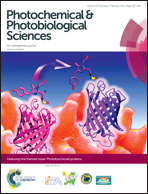Pigment violet 19 – a test case to define a simple method to simulate the vibronic structure of absorption spectra of organic pigments and dyes in solution
Abstract
A typical quinacridone pigment, PV19, has been used to analyze the impact of several computational parameters on the UV/vis absorption band shape in solution, simulated using density functional theory and time-dependent density functional theory levels of approximation. These encompass, (i) the choice of exchange–correlation functional, (ii) the basis set, (iii) the method for non-equilibrium optimization of the excited state geometry, (iv) the approach for evaluating the vibronic band structure, (v) the peak broadening, and (vi) the scaling of the harmonic vibrational frequencies. Among these, the choice of exchange–correlation functional is certainly of the most importance because it can drastically modify the spectral shape. In the case of PV19, the M05-2X and to a lesser extent CAM-B3LYP XC functionals are the most efficient to reproduce the vibronic structure, confirming the important role of exact Hartree–Fock exchange. Still, these functionals are not the most reliable to predict the excitation energies and oscillator strengths, for which M05, a functional with less HF exchange, performs better. For evaluating the vibronic structure, the simple gradient method, where only one step of geometry optimization of the excited state is carried out and the gradients are used to evaluate the Huang–Rhys factors as well as to determine the excited state geometries produces a spectrum that is very similar to the ones obtained with the more involved Duschinsky and geometry methods, opening the way to a fast simulation of the UV/vis absorption spectra of pigments and dyes. Then, the effect of scaling the calculated vibrational frequencies to account for anharmonicity effects as well as for limitation of the method also impacts the shape of the vibronic spectrum and this effect depends on the method used to determine the Huang–Rhys factors. Indeed, scaling the vibrational frequencies by a factor which is typically smaller than 1.0 results in a relative decrease of the 0–1 peak intensity with respect to the 0–0 band when optimizing the geometry of the excited state whereas the effect is opposite and magnified if using the gradient method.


 Please wait while we load your content...
Please wait while we load your content...